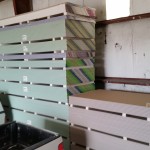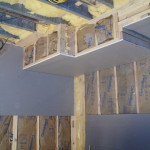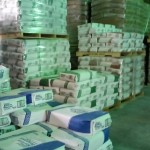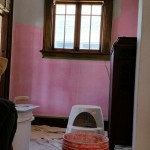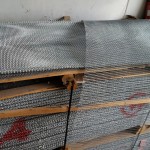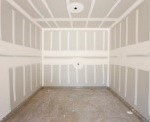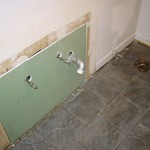Blueboard and Plaster
Blueboard is covered in a paper that is feltier or more fibrous. When plaster is applied these microfibers become imbedded in the plaster for greater adhesion. The paper has also been treated with bonding agent, again to improve plaster bonding to the paper. Unlike sheetrock, the paper on blueboard is very porous which creates a suction on the wet plaster thus drawing the wet plaster into the pours for still greater bonding. This suction action is an important property when it comes to troweling the plaster smooth and makes life much easier for plasterers when compared to plastering over other surfaces. Blue board must be used with one coat plastering and is the preferred substrate for two coat plastering although sheetrock can also be used with two coat plaster but it does represent additional challenges to the plasterers. You cannot use joint compound to finish blueboard.
There are also other substrates that plaster can be applied to such as steel mesh, or wood lath as seen with the old horsehair plaster, which may be required if your property is listed as a historical landmark building. Preexisting surfaces that are structurally sound can be coated with a bonding agent and resurfaced with two coat plaster. There are several different types of plasters and several manufacturers of blue board. Each company’s product has slightly different properties when it comes to how they are applied and worked to a finish. Pairing the right plaster and blueboard together matters to plasterers, so if you are thinking of installing your own blueboard and have a plaster finish it, make sure you consult them before buying materials. In the end the finished product you end up with is a stone surface covered by paint.
Plaster application and finishing requires much more skill then mudding sheetrock, as you cannot effectively sand away bad plaster work without having negative impact on the quality of the finished product, so you have to get it right the first time, every time. Plasters come as a powder and must be mixed on site at the time of use. All plasters utilize a chemical reaction we called setting to get hard, just like cement. Plaster can withstand getting wet and being exposed to high humidity areas much better then joint compounds can. There are many different types of plaster and each plasterer has his favorites. Here in the Midwest the most commonly used brands are Kal-Kote and Unikal. Kal-Kote is a two coat system which consist of an extremely hard cement like base coat which is applied to the blueboard and then is finished with either a smooth plaster or a texturing plaster. Unikal is a one coat system which is applied directly to the blueboard after the joints have had a coat of Kal-Kote base coat put on them. Unikal can also be used for texturing as well as for smooth finishes.
There are also different additives for plaster to speed up the setting action or slow it down. There are fillers that can be added to make plaster less dense when it needs to be applied to metal lath, wood lath or if thick plaster is needed to feather out deep transitional areas or to fill big holes. Sands can also be used to get different texturing effects. Plaster, because of its properties and the fact that you cover the entire surface instead of simply making a raised mound over what you are trying to hide as with joint compound, allows the plasterer more leeway in utilizing trade secrets to create a more durable and uniform surface for paint.
There are many factors that impact how plaster reacts. Substrates, temperature, humidity, air flow, what is in the water and how long you mix it all must be taken into account by the plaster to decide if he should use additives and how much to mix up. The amount of area you are trying to cover, how many corners you have to deal with and how thick you need to lay it on as well as is it a one coat or two coat system, is it a smooth finish or a texture and what type of texture as well as is it being applied to a bonded surface all dictate how thick you will want it. It quickly becomes obvious why the untrained should not use plaster.


